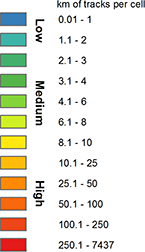Approaching potential conflict in a busy ocean
Mapping a data goldmine
New data drives new conversations
Exploring new uses, partnerships through mapping ocean data
Apart from tracking shipping data, the Coast Guard has recognizes several other ways the data in the Portal can help them achieve their missions.
"One of the other aspects that have helped us out was the mapping of coral," Walters said. "We had no understanding of where the essential fish habitat was, what it was nor again where the coral was. If we’re looking at the creation of off-shore anchorages and aids to navigation we need to know that the bottom is clear of coral."
In addition to knowing where cold water coral exists, Walters said the accumulation of data around fishing is also very helpful for the Coast Guard.
"In years past it’s been very difficult to obtain any information about where fishing activity occurs," Walters said. "Through the efforts of MARCO and its stakeholder outreach I think fishermen both commercial and recreational have been able to fill a vacuum. We had no visibility about how fishing activity interacted with commercial shipping."
"Essentially the portal provides one stop shopping to determine multiple objectives," Walters said.
